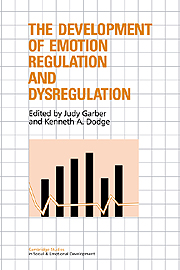Book contents
- Frontmatter
- Contents
- List of contributors
- Preface
- Part I Introduction
- Part II Early development
- Part III Physiological regulation
- Part IV Cognitive regulation
- 8 Emotion and social information processing
- 9 Strategies and mechanisms for the personal and social control of emotion
- 10 The regulation of sad affect: An information-processing perspective
- Part V Psychopathology
- Part VI Integration
- Author index
- Subject index
10 - The regulation of sad affect: An information-processing perspective
Published online by Cambridge University Press: 26 March 2010
- Frontmatter
- Contents
- List of contributors
- Preface
- Part I Introduction
- Part II Early development
- Part III Physiological regulation
- Part IV Cognitive regulation
- 8 Emotion and social information processing
- 9 Strategies and mechanisms for the personal and social control of emotion
- 10 The regulation of sad affect: An information-processing perspective
- Part V Psychopathology
- Part VI Integration
- Author index
- Subject index
Summary
According to Lang (1968, 1984) and more recently Dodge (1989; Dodge & Garber, Chapter 1, this volume), the regulation of emotions involves three systems: neurophysiological-biochemical, motor- or behavior-expressive, and cognitive- or subjective-experiential. Although we recognize that the integration of all three processes is important to the regulation of emotions, our discussion will focus on the cognitive and behavioral aspects of affect regulation. In particular, this chapter is concerned with the self-regulation strategies that children use to alter their negative emotions and to maintain or enhance their positive affect states.
First, we suggest that an information-processing framework can be used to describe both competent and maladaptive emotion regulation. Two studies are presented in which the strategies accessed by normal school-age children to modify their negative moods are contrasted with the affect regulation strategies used by children who are experiencing the more intense negative emotional state of depression. We offer several hypotheses derived from the information-processing perspective to explain the different emotion regulation strategies of depressed and nondepressed children. Second, we discuss how affect regulation strategies may be socialized in parent-child interactions. The impact on this socialization process when the mother is depressed is addressed in two other studies.
The comparison of the affect regulation strategies of depressed and nondepressed children is important for several reasons. First, it is relevant to the issue of whether there is continuity between normal sadness and the more severe, chronic, and intense disorder of depression (Rutter, Chapter 12, this volume).
- Type
- Chapter
- Information
- The Development of Emotion Regulation and Dysregulation , pp. 208 - 240Publisher: Cambridge University PressPrint publication year: 1991
- 91
- Cited by



